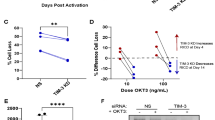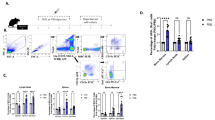Abstract
A key issue in mammalian immunology is how CD4+CD25+Foxp3+ regulatory T cells (Treg cells) suppress immune responses. Here we show that Treg cells induced apoptosis of effector CD4+ T cells in vitro and in vivo in a mouse model of inflammatory bowel disease. Treg cells did not affect the early activation or proliferation of effector CD4+ T cells. Cytokines that signal through the common γ-chain suppressed Treg cell–induced apoptosis. Treg cell–induced effector CD4+ T cell death required the proapoptotic protein Bim, and effector CD4+ T cells incubated with Treg cells showed less activation of the prosurvival kinase Akt and less phosphorylation of the proapoptotic protein Bad. Thus, cytokine deprivation–induced apoptosis is a prominent mechanism by which Treg cells inhibit effector T cell responses.
This is a preview of subscription content, access via your institution
Access options
Subscribe to this journal
Receive 12 print issues and online access
$209.00 per year
only $17.42 per issue
Buy this article
- Purchase on Springer Link
- Instant access to full article PDF
Prices may be subject to local taxes which are calculated during checkout








Similar content being viewed by others
References
Fontenot, J.D., Gavin, M.A. & Rudensky, A.Y. Foxp3 programs the development and function of CD4+CD25+ regulatory T cells. Nat. Immunol. 4, 330–336 (2003).
Hori, S., Nomura, T. & Sakaguchi, S. Control of regulatory T cell development by the transcription factor Foxp3. Science 299, 1057–1061 (2003).
Sakaguchi, S., Sakaguchi, N., Asano, M., Itoh, M. & Toda, M. Immunologic self-tolerance maintained by activated T cells expressing IL-2 receptor α-chains (CD25). Breakdown of a single mechanism of self-tolerance causes various autoimmune diseases. J. Immunol. 155, 1151–1164 (1995).
Ono, M. et al. Foxp3 controls regulatory T-cell function by interacting with AML1/Runx1. Nature 446, 685–689 (2007).
D'Cruz, L.M. & Klein, L. Development and function of agonist-induced CD25+Foxp3+ regulatory T cells in the absence of interleukin 2 signaling. Nat. Immunol. 6, 1152–1159 (2005).
Fontenot, J.D., Rasmussen, J.P., Gavin, M.A. & Rudensky, A.Y. A function for interleukin 2 in Foxp3-expressing regulatory T cells. Nat. Immunol. 6, 1142–1151 (2005).
Maloy, K.J. & Powrie, F. Fueling regulation: IL-2 keeps CD4+ Treg cells fit. Nat. Immunol. 6, 1071–1072 (2005).
von Boehmer, H. Mechanisms of suppression by suppressor T cells. Nat. Immunol. 6, 338–344 (2005).
Takahashi, T. et al. Immunologic self-tolerance maintained by CD25+CD4+ naturally anergic and suppressive T cells: induction of autoimmune disease by breaking their anergic/suppressive state. Int. Immunol. 10, 1969–1980 (1998).
Thornton, A.M. & Shevach, E.M. CD4+CD25+ immunoregulatory T cells suppress polyclonal T cell activation in vitro by inhibiting interleukin 2 production. J. Exp. Med. 188, 287–296 (1998).
Sojka, D.K., Hughson, A., Sukiennicki, T.L. & Fowell, D.J. Early kinetic window of target T cell susceptibility to CD25+ regulatory T cell activity. J. Immunol. 175, 7274–7280 (2005).
Klein, L., Khazaie, K. & von Boehmer, H. In vivo dynamics of antigen-specific regulatory T cells not predicted from behavior in vitro. Proc. Natl. Acad. Sci. USA 100, 8886–8891 (2003).
Thornton, A.M. & Shevach, E.M. Suppressor effector function of CD4+CD25+ immunoregulatory T cells is antigen nonspecific. J. Immunol. 164, 183–190 (2000).
Asseman, C., Mauze, S., Leach, M.W., Coffman, R.L. & Powrie, F. An essential role for interleukin 10 in the function of regulatory T cells that inhibit intestinal inflammation. J. Exp. Med. 190, 995–1004 (1999).
Fahlen, L. et al. T cells that cannot respond to TGF-β escape control by CD4+CD25+ regulatory T cells. J. Exp. Med. 201, 737–746 (2005).
Kullberg, M.C. et al. TGF-beta1 production by CD4+CD25+ regulatory T cells is not essential for suppression of intestinal inflammation. Eur. J. Immunol. 35, 2886–2895 (2005).
Kataoka, H. et al. CD25+CD4+ regulatory T cells exert in vitro suppressive activity independent of CTLA-4. Int. Immunol. 17, 421–427 (2005).
Thornton, A.M., Piccirillo, C.A. & Shevach, E.M. Activation requirements for the induction of CD4+CD25+ T cell suppressor function. Eur. J. Immunol. 34, 366–376 (2004).
Asseman, C., Read, S. & Powrie, F. Colitogenic Th1 cells are present in the antigen-experienced T cell pool in normal mice: control by CD4+ regulatory T cells and IL-10. J. Immunol. 171, 971–978 (2003).
Read, S. et al. Blockade of CTLA-4 on CD4+CD25+ regulatory T cells abrogates their function in vivo. J. Immunol. 177, 4376–4383 (2006).
Lenardo, M.J. Interleukin-2 programs mouse αβ T lymphocytes for apoptosis. Nature 353, 858–861 (1991).
Zheng, L., Trageser, C.L., Willerford, D.M. & Lenardo, M.J. T cell growth cytokines cause the superinduction of molecules mediating antigen-induced T lymphocyte death. J. Immunol. 160, 763–769 (1998).
Lenardo, M. et al. Mature T lymphocyte apoptosis–immune regulation in a dynamic and unpredictable antigenic environment. Annu. Rev. Immunol. 17, 221–253 (1999).
Gondek, D.C., Lu, L.F., Quezada, S.A., Sakaguchi, S. & Noelle, R.J. Cutting edge: contact-mediated suppression by CD4+CD25+ regulatory cells involves a granzyme B-dependent, perforin-independent mechanism. J. Immunol. 174, 1783–1786 (2005).
Grossman, W.J. et al. Human T regulatory cells can use the perforin pathway to cause autologous target cell death. Immunity 21, 589–601 (2004).
Pace, L., Pioli, C. & Doria, G. IL-4 modulation of CD4+CD25+ T regulatory cell-mediated suppression. J. Immunol. 174, 7645–7653 (2005).
Ahmed, N.N., Grimes, H.L., Bellacosa, A., Chan, T.O. & Tsichlis, P.N. Transduction of interleukin-2 antiapoptotic and proliferative signals via Akt protein kinase. Proc. Natl. Acad. Sci. USA 94, 3627–3632 (1997).
Datta, S.R., Brunet, A. & Greenberg, M.E. Cellular survival: a play in three Akts. Genes Dev. 13, 2905–2927 (1999).
Strasser, A. et al. The role of bim, a proapoptotic BH3-only member of the Bcl-2 family in cell-death control. Ann. NY Acad. Sci. 917, 541–548 (2000).
Datta, S.R. et al. Akt phosphorylation of Bad couples survival signals to the cell-intrinsic death machinery. Cell 91, 231–241 (1997).
Barthlott, T. et al. CD25+CD4+ T cells compete with naive CD4+ T cells for IL-2 and exploit it for the induction of IL-10 production. Int. Immunol. 17, 279–288 (2005).
de la Rosa, M., Rutz, S., Dorninger, H. & Scheffold, A. Interleukin-2 is essential for CD4++CD25+ regulatory T cell function. Eur. J. Immunol. 34, 2480–2488 (2004).
Lindstein, T., June, C.H., Ledbetter, J.A., Stella, G. & Thompson, C.B. Regulation of lymphokine messenger RNA stability by a surface-mediated T cell activation pathway. Science 244, 339–343 (1989).
Thornton, A.M., Donovan, E.E., Piccirillo, C.A. & Shevach, E.M. Cutting edge: IL-2 is critically required for the in vitro activation of CD4+CD25+ T cell suppressor function. J. Immunol. 172, 6519–6523 (2004).
Harnaha, J. et al. Interleukin-7 is a survival factor for CD4+CD25+ T-cells and is expressed by diabetes-suppressive dendritic cells. Diabetes 55, 158–170 (2006).
Sojka, D.K., Bruniquel, D., Schwartz, R.H. & Singh, N.J. IL-2 secretion by CD4+ T cells in vivo is rapid, transient, and influenced by TCR-specific competition. J. Immunol. 172, 6136–6143 (2004).
Uhlig, H.H. et al. Characterization of Foxp3+CD4+CD25+ and IL-10-secreting CD4+CD25+ T cells during cure of colitis. J. Immunol. 177, 5852–5860 (2006).
Mottet, C., Uhlig, H.H. & Powrie, F. Cutting edge: cure of colitis by CD4+CD25+ regulatory T cells. J. Immunol. 170, 3939–3943 (2003).
Makita, S. et al. Intestinal lamina propria retaining CD4+CD25+ regulatory T cells is a suppressive site of intestinal inflammation. J. Immunol. 178, 4937–4946 (2007).
Tang, Q. et al. Visualizing regulatory T cell control of autoimmune responses in nonobese diabetic mice. Nat. Immunol. 7, 83–92 (2006).
Strasser, A. The role of BH3-only proteins in the immune system. Nat. Rev. Immunol. 5, 189–200 (2005).
Scheffold, A., Huhn, J. & Hofer, T. Regulation of CD4+CD25+ regulatory T cell activity: it takes (IL-)two to tango. Eur. J. Immunol. 35, 1336–1341 (2005).
Tadokoro, C.E. et al. Regulatory T cells inhibit stable contacts between CD4+ T cells and dendritic cells in vivo. J. Exp. Med. 203, 505–511 (2006), Epub 2006 Mar 13.
Mempel, T.R. et al. Regulatory T cells reversibly suppress cytotoxic T cell function independent of effector differentiation. Immunity 25, 129–141 (2006).
Martin, B. et al. Suppression of CD4+ T lymphocyte effector functions by CD4+CD25+ cells in vivo. J. Immunol. 172, 3391–3398 (2004).
Schimpl, A. et al. IL-2 and autoimmune disease. Cytokine Growth Factor Rev. 13, 369–378 (2002).
Pasare, C. & Medzhitov, R. Toll pathway-dependent blockade of CD4+CD25+ T cell-mediated suppression by dendritic cells. Science 299, 1033–1036 (2003).
Deaglio, S. et al. Adenosine generation catalyzed by CD39 and CD73 expressed on regulatory T cells mediates immune suppression. J. Exp. Med. 204, 1257–1265 (2007).
Wildey, G.M., Patil, S. & Howe, P.H. Smad3 potentiates transforming growth factor β (TGFβ)-induced apoptosis and expression of the BH3-only protein Bim in WEHI 231 B lymphocytes. J. Biol. Chem. 278, 18069–18077 (2003).
Rudensky, A.Y. & Campbell, D.J. In vivo sites and cellular mechanisms of Treg cell-mediated suppression. J. Exp. Med. 203, 489–492 (2006).
Acknowledgements
We thank R. Germain, R. Schwartz, N. Singh, B. Paul, E. Shevach, R. Siegel, A. Singer, S. Saravanamuthu, D. Simon, H. Su, L. Yu, N. Bidere, C. Trageser, J. Lee, A. Snow and other members of the Lenardo laboratory for suggestions and help; O. Schwartz, M. Czapiga and L. Koo for help in confocal microscopy; and K. Nagashima for assistance in electron microscopy. Spleens from Prf1−/− and gld mice (BALB/c) were from T. Sayers and A. Shanker (National Cancer Institute); Bcl-2 transgenic (CD45.1+) mice were from A. Singer (National Cancer Institute); and spleens from Bim-deficient mice (C57BL/6) were obtained from S. Durum and W. Li (National Cancer Institute). Supported by the intramural research program of the National Institute of Allergy and Infectious Diseases, National Institutes of Health; the National Institutes of Health–University of Pennsylvania Immunology graduate partnership program (J.R.); and the National Academy of Sciences/National Research Council (P.P.).
Author information
Authors and Affiliations
Contributions
P.P. designed the study, did experiments and analyzed data with the direction and supervision of M.J.L.; M.J.L. and P.P. wrote the manuscript; L.Z. did ELISAs, analyzed the data and contributed to discussions; S.I. did real-time PCR and analyzed the data; and J.R. helped P.P. in sorting cells for some experiments.
Corresponding author
Supplementary information
Supplementary Text and Figures
Supplementary Figures 1–9, Discussion and Methods (PDF 2733 kb)
Rights and permissions
About this article
Cite this article
Pandiyan, P., Zheng, L., Ishihara, S. et al. CD4+CD25+Foxp3+ regulatory T cells induce cytokine deprivation–mediated apoptosis of effector CD4+ T cells. Nat Immunol 8, 1353–1362 (2007). https://doi.org/10.1038/ni1536
Received:
Accepted:
Published:
Issue Date:
DOI: https://doi.org/10.1038/ni1536
This article is cited by
-
Reigniting hope in cancer treatment: the promise and pitfalls of IL-2 and IL-2R targeting strategies
Molecular Cancer (2023)
-
Canine diffuse large B-cell lymphoma downregulates the activity of CD8 + T-cells through tumor-derived extracellular vesicles
Cancer Cell International (2023)
-
Emerging hallmark of gliomas microenvironment in evading immunity: a basic concept
The Egyptian Journal of Neurology, Psychiatry and Neurosurgery (2023)
-
Polyamine metabolism impacts T cell dysfunction in the oral mucosa of people living with HIV
Nature Communications (2023)
-
circ_SPEF2 Regulates the Balance of Treg Cells by Regulating miR-16-5p/BACH2 in Lymphoma and Participates in the Immune Response
Tissue Engineering and Regenerative Medicine (2023)



